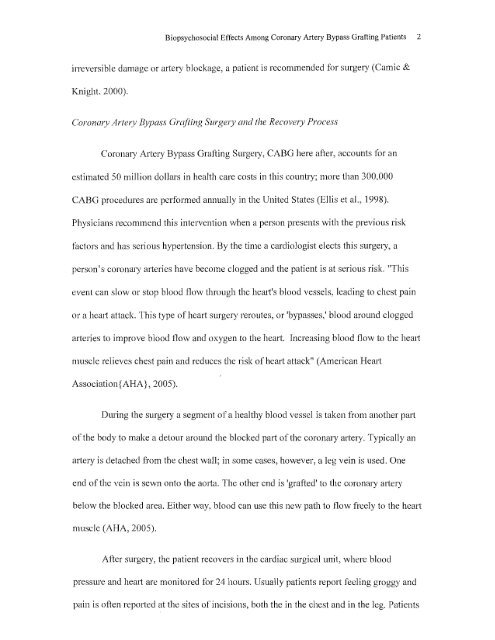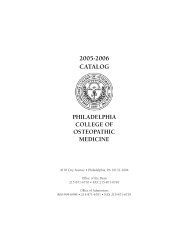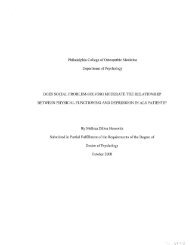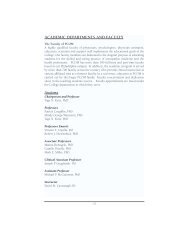0 - Philadelphia College of Osteopathic Medicine
0 - Philadelphia College of Osteopathic Medicine
0 - Philadelphia College of Osteopathic Medicine
You also want an ePaper? Increase the reach of your titles
YUMPU automatically turns print PDFs into web optimized ePapers that Google loves.
Biopsychosocial Effects Among Coronary Artery Bypass Grafting Patients<br />
irreversible damage or artery blockage, a patient is recommended for surgery (Carnic &<br />
Knight. 2000).<br />
Coronary Arter}' Bypass Grafting 5'urgery and the Recovery Process<br />
Coronary Artery B)lJaSS Grafting Surgery, CABG here after, accounts for an<br />
estimated 50 million dollars in health care costs in this countTY; more than 300,000<br />
CABG procedures are performed annually in the United States (Ellis et aI., 1998).<br />
Physicians recommend this intervention when a person presents with the previous risk<br />
11{ctors and has serious hypertension. By the time a cardiologist elects this surgery, a<br />
person's coronary arteries have become clogged and the patient is at serious risk. "This<br />
event can slmv or stop blood f10w through the heart's blood vessels, leading to chest pain<br />
or a heart attack. This type <strong>of</strong> heart surgery reroutes, or 'bypasses,' blood around clogged<br />
arteries to improve blood flow and oxygen to the heart. Increasing blood flO\v to the hem1<br />
muscle relieves chest pain and reduces the risk <strong>of</strong> heart attack" (American Heart<br />
Association {AHA}, 2005).<br />
During the surgery a segment <strong>of</strong> a healthy blood vessel is taken from another part<br />
<strong>of</strong> the body to make a detour around the blocked part <strong>of</strong> the coronmy artery. Typically an<br />
artery is detached from the chest wall; in some cases, however, a leg vein is used. One<br />
end <strong>of</strong> the vein is sewn onto the aorta. The other end is 'grafted' to the coronary artery<br />
below the blocked area. Either way, blood can use this new path to flow freely to the heart<br />
muscle (AHA, 2005).<br />
After surgery, the patient recovers in the cardiac surgical unit, \V'here blood<br />
pressure and heati are monitored for 24 hours. Usually patients report feeling groggy and<br />
pain is otten reported at the sites <strong>of</strong> incisions, both the in the chest and in the leg. Patients<br />
2






